Shining Cities
Harnessing the Benefits of Solar Energy in America
The use of solar power is expanding rapidly across the United States. By the end of 2014, the United States had 20,500 megawatts (MW) of cumulative solar electric capacity, enough to power four million average U.S. homes. This success is the outcome of federal, state and local programs that are working in concert to make solar power accessible to more Americans, thereby cleaning our air, protecting our health, and hedging against volatile electricity prices. America’s major cities have played key roles in the clean energy revolution and stand to reap significant benefits from solar energy adoption. As population centers, they are home to the largest electricity markets and can have an important influence on the way we power our grid. Many cities are already benefitting from smart policies that encourage investment in solar energy.
Downloads
Executive Summary
The use of solar power is expanding rapidly across the United States. By the end of 2014, the United States had 20,500 megawatts (MW) of cumulative solar electric capacity, enough to power four million average U.S. homes. This success is the outcome of federal, state and local programs that are working in concert to make solar power accessible to more Americans, thereby cleaning our air, protecting our health, and hedging against volatile electricity prices.
America’s major cities have played key roles in the clean energy revolution and stand to reap significant benefits from solar energy adoption. As population centers, they are home to the largest electricity markets and can have an important influence on the way we power our grid. Many cities are already benefitting from smart policies that encourage investment in solar energy.
As of the end of 2014, 20 cities – representing just 0.1 percent of U.S. land area – account for 6.5 percent of solar photovoltaic (PV) capacity in the United States. The 65 cities in this report have installed 1.3 gigawatts (GW) of solar PV capacity – more solar PV than was installed in the entire country at the end of 2009. Los Angeles leads the nation in total installed solar PV capacity, followed by San Diego, Phoenix, Indianapolis and San Jose. (See Figure ES-1 and Table ES-1.)
Table ES-1: Top 20 Solar Cities by Total Installed Solar PV Capacity, End of 2014*
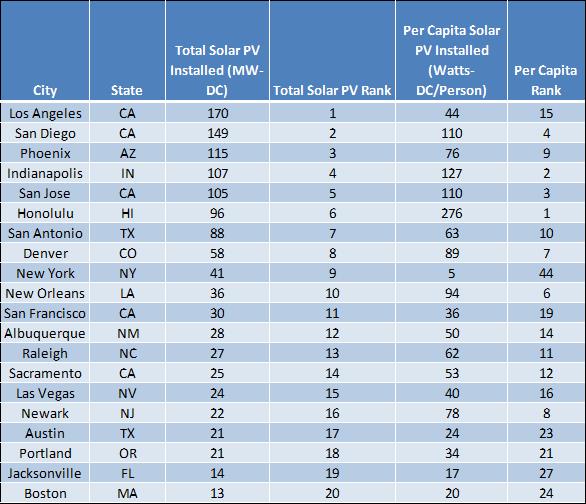
* This includes all solar PV capacity (rooftop and utility-scale solar installations) within the city limits of each city. See methodology for an explanation of how these rankings were calculated. See Appendix B for city-specific sources of data.
Figure ES-1: U.S. Cities by Cumulative Installed Solar PV Capacity, End of 2014
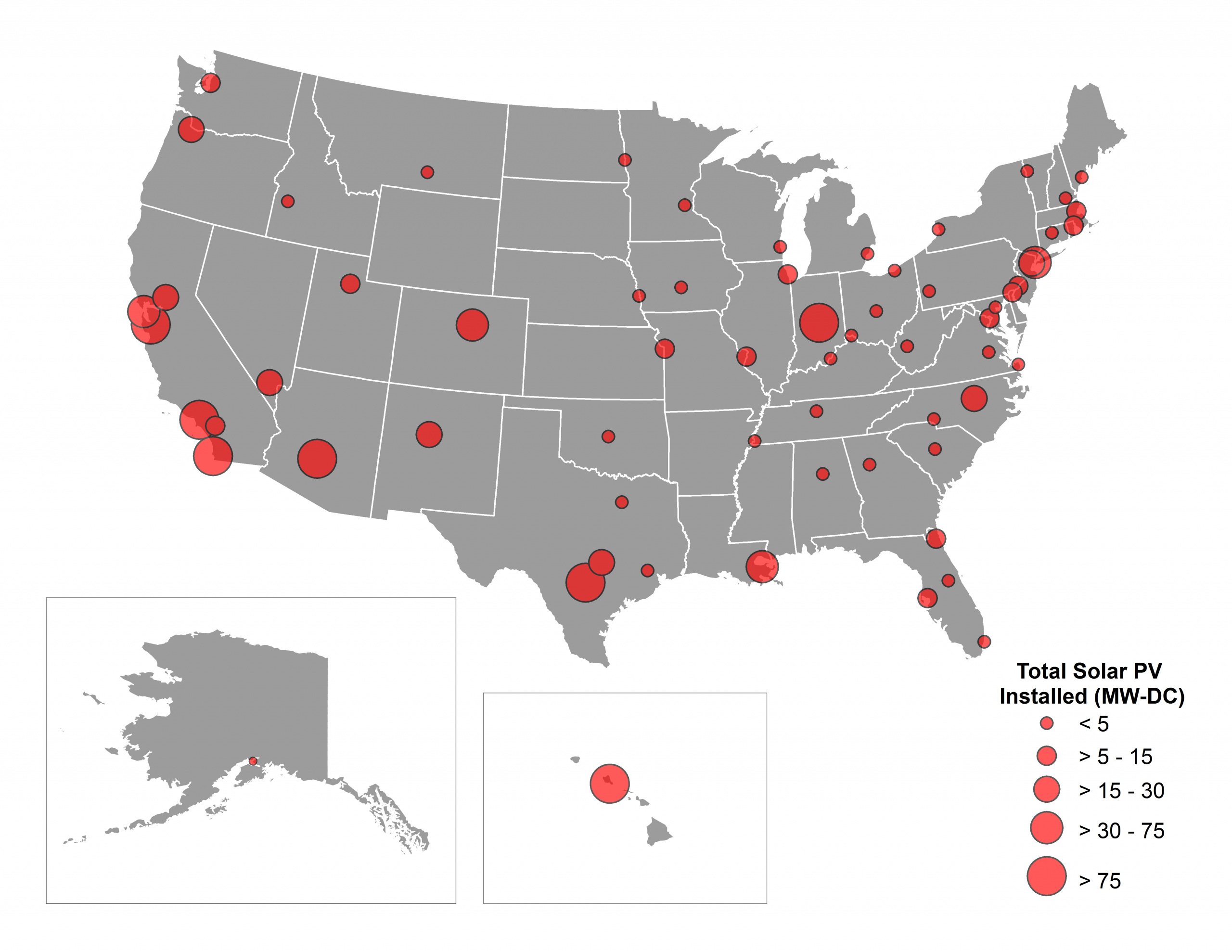
The cities with the most solar PV installed per person are the “Solar Stars” – cities with 50 or more watts of installed solar PV capacity per person. These cities have experienced dramatic growth in solar energy and are setting the pace nationally for solar energy development. Honolulu, Indianapolis, San Jose, San Diego and Wilmington, Delaware, are the top 5 cities in the nation for installed solar PV capacity per person. (See Figure ES-2 and Table ES-2.)
Figure ES-2: U.S. Cities by Per Capita Installed Solar PV Capacity, End of 2014
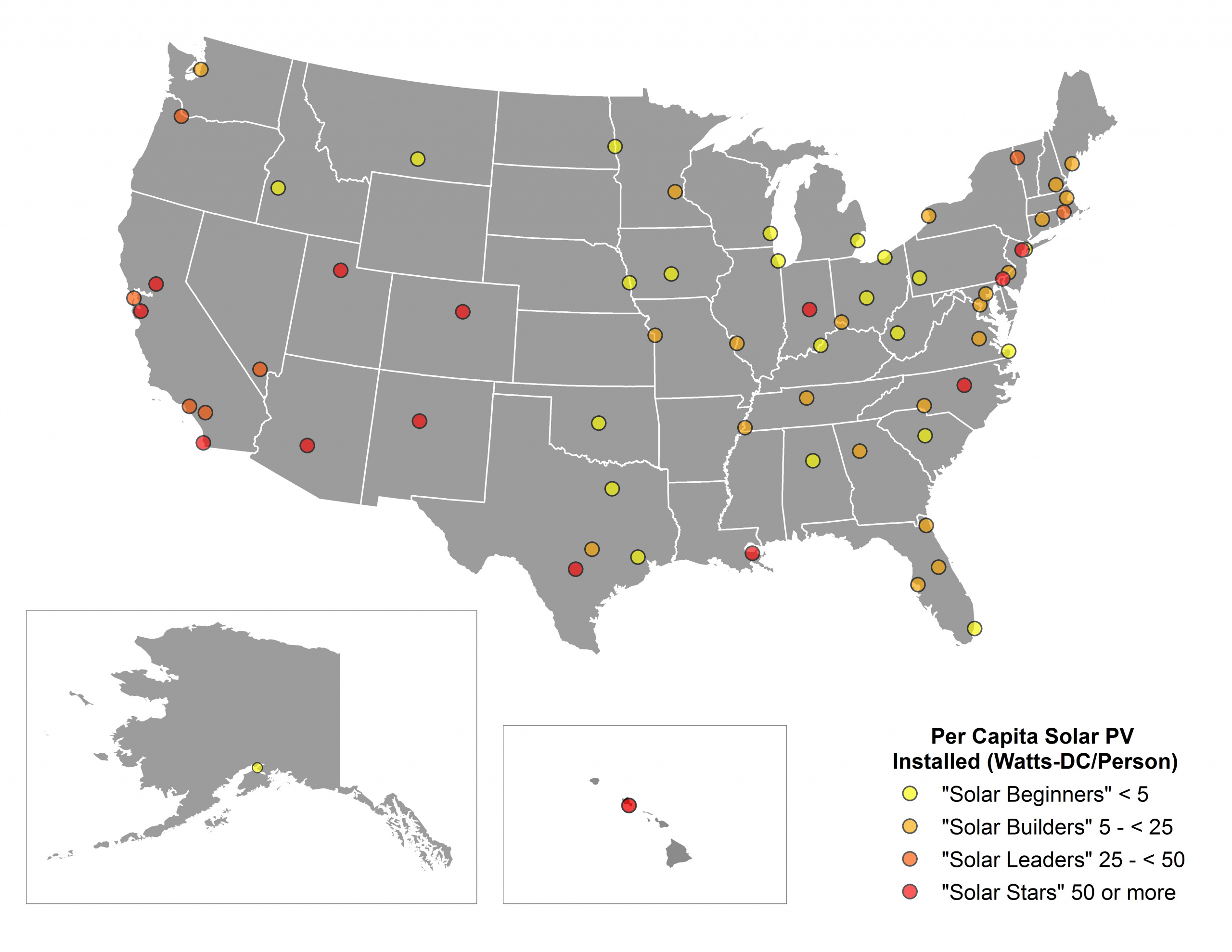
Table ES-2: The “Solar Stars” (Cities with 50 or More Watts of Solar PV per Person, End of 2014)
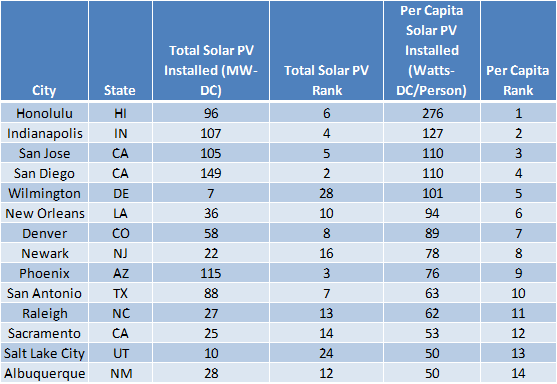
Cities were also divided into U.S. Census sub-regions and ranked by solar PV capacity installed per person. New cities stand out when categorized and ranked by U.S. region. Regional leaders are Honolulu in the Pacific region, Denver in the Mountain region, Indianapolis in the North Central regions, New Orleans in the South Central regions, Wilmington, Delaware in the South Atlantic region, and Newark, New Jersey in the New England and Mid-Atlantic regions.
Table ES-3: Top Two U.S. Cities by Region by Per Capita Installed Solar PV Capacity, End of 2014
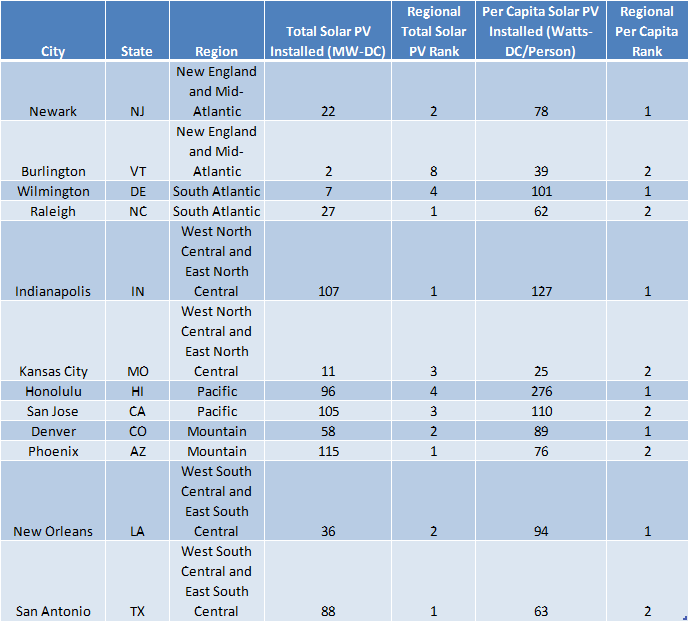
Solar power makes sense for cities. Solar power reduces the threat to cities posed by global warming, cuts down on toxic air pollution, fortifies cities against severe weather events and boosts local economies:
- By switching to solar energy, cities can do their part to mitigate the dangerous impacts of global warming. Solar power produces 96 percent less global warming pollution than coal-fired power plants over its entire life-cycle. Mitigating global warming pollution is important for cities: in 2014, there were eight weather events that caused damage valued at more than $1 billion each in the United States – seven of which involved severe storms and intense precipitation. Recent studies suggest that as global warming progresses, the intensity and frequency of extreme storms are likely to increase.
- Increasing solar energy production in cities allows residents and businesses to reduce air pollution. Electricity production is a large source of pollution in the United States, affecting air quality and human health. A 2013 study from MIT found that the fine particles released into the air from burning fossil fuels for energy caused 52,000 early deaths per year in the United States in 2005. As major centers of energy consumption, cities that acquire more of their energy from the sun can help to better the quality of our nation’s air.
- Solar energy strengthens city electric grids. If transmission lines are disrupted from a severe storm or heat wave, solar panels attached to batteries can help avoid blackouts. With the right configuration, a property owner with a solar PV system can have the option to go temporarily “off the grid,” dropping non-essential loads to keep the power on for essential appliances.
- Solar energy spurs economic growth in cities. Demand for solar power brings solar developers to town, creating local jobs that are well paid and offering positions for a variety of skills, from technical maintenance to sales. As of November 2014, 173,807 people were employed in the United States solar industry, a 21.8 percent increase from November 2013.
Cities can reap the benefits of clean, solar energy by adopting pro-solar policies and taking actions that will encourage innovation and investment in the solar industry. Many leading cities have successfully built their solar energy markets with local government policies. Some leading cities are in states that have taken state-level action to promote solar energy adoption. Some of the most effective drivers of solar energy development include:
- Streamlining the permitting process for solar power. The “soft costs” associated with solar power – costs such as those associated with attracting customers, installing the systems, completing paperwork, and paying taxes and permitting fees – can make up to 64 percent of the total cost of an installed solar energy system, as of 2013. The Department of Energy’s SunShot Initiative rewards cities working to reduce these costs with funds to implement programs that make permitting processes easier, increase solar financing options or reduce the upkeep costs over time.
- Removing local barriers to solar energy adoption. Encouraging local lending for solar projects, providing predictable tax incentives that make solar energy more affordable, and adopting solar-friendly permitting policies and building codes have proven critical in building strong solar energy markets.
- Expanding access to solar. “Solarize” programs and community solar programs have been successful at lowering the cost of solar energy systems for communities, and allowing more people to receive the benefits of solar energy. Solarize programs, like those in Portland, Oregon, allow communities to bulk purchase solar energy systems in order to receive volume discounts. In Washington D.C., local officials passed a community solar act in 2013 that allows residents to buy ownership of off-site panels and receive credit on their electricity bills for the solar energy produced.
- Partnering with local utilities. Municipal utilities in several cities have driven the growth of solar power by setting renewable energy goals and offering financial incentives for solar projects. Cities served by investor-owned utilities (IOUs) make up a large part of an IOU’s customer base and can also effectively partner with the electric utility to promote solar energy adoption. New York City partnered with Con Edison, its local IOU, to connect solar power to the city grid and created designated “Solar Empowerment Zones” where solar power could deliver the most benefits.
Strong public policies at every level of government can help the United States continue to harness clean solar energy and overcome legislative and regulatory barriers to distributed generation. To achieve the nation’s full solar potential:
- Local governments should follow the lead of top solar cities by setting strong goals for solar energy adoption, implementing programs that promote the rapid expansion of solar energy, and urging state and federal officials and investor-owned utilities to facilitate that expansion.
- State governments should set ambitious goals for solar energy adoption and adopt policies to meet them. It is critical that states have strong net metering laws in order to make solar installations accessible and affordable. States can also pass strong renewable portfolio standards with solar carve-outs, community solar legislation, tax credits for solar energy, promote solar programs for low-income households, and establish public benefits charges on electricity bills to raise funds for solar energy programs. State governments should also use their role as the primary regulators of electric utilities to encourage utility investments in solar energy and implement rate structures that maximize the benefits of solar energy to consumers.
- The federal government should continue to provide long-term support for solar power through tax credits, grants to non-profits for solar energy development, and grants to support solar energy deployment on low income housing developments, in addition to other incentives. The federal government should continue to support research, development and deployment efforts designed to reduce the cost of solar energy and to speed the integration of renewables, storage and smart grid technologies into the grid.
Think it’s time for America to go solar? You can take action here.

